Managing Across Borders: Outsourcing Role and Impact Analysis
VerifiedAdded on 2022/09/22
|10
|1897
|25
Report
AI Summary
This report provides a comprehensive overview of outsourcing, defining the concept and exploring its advantages and disadvantages. It highlights how outsourcing can lead to cost savings, specialized expertise, and a focus on core competencies, but also discusses potential risks such as data confidentiality and hidden costs. The report emphasizes the crucial role of outsourcing in global business, including its contribution to global expansion, market competitiveness, and addressing changing customer demands. It supports its arguments with practical examples, such as Alibaba and Tata Consultancy Services, illustrating how outsourcing strategies can be applied effectively in international contexts. The conclusion stresses the importance of careful assessment of outsourcing providers, cost transparency, and alignment with organizational objectives to achieve desired outcomes.
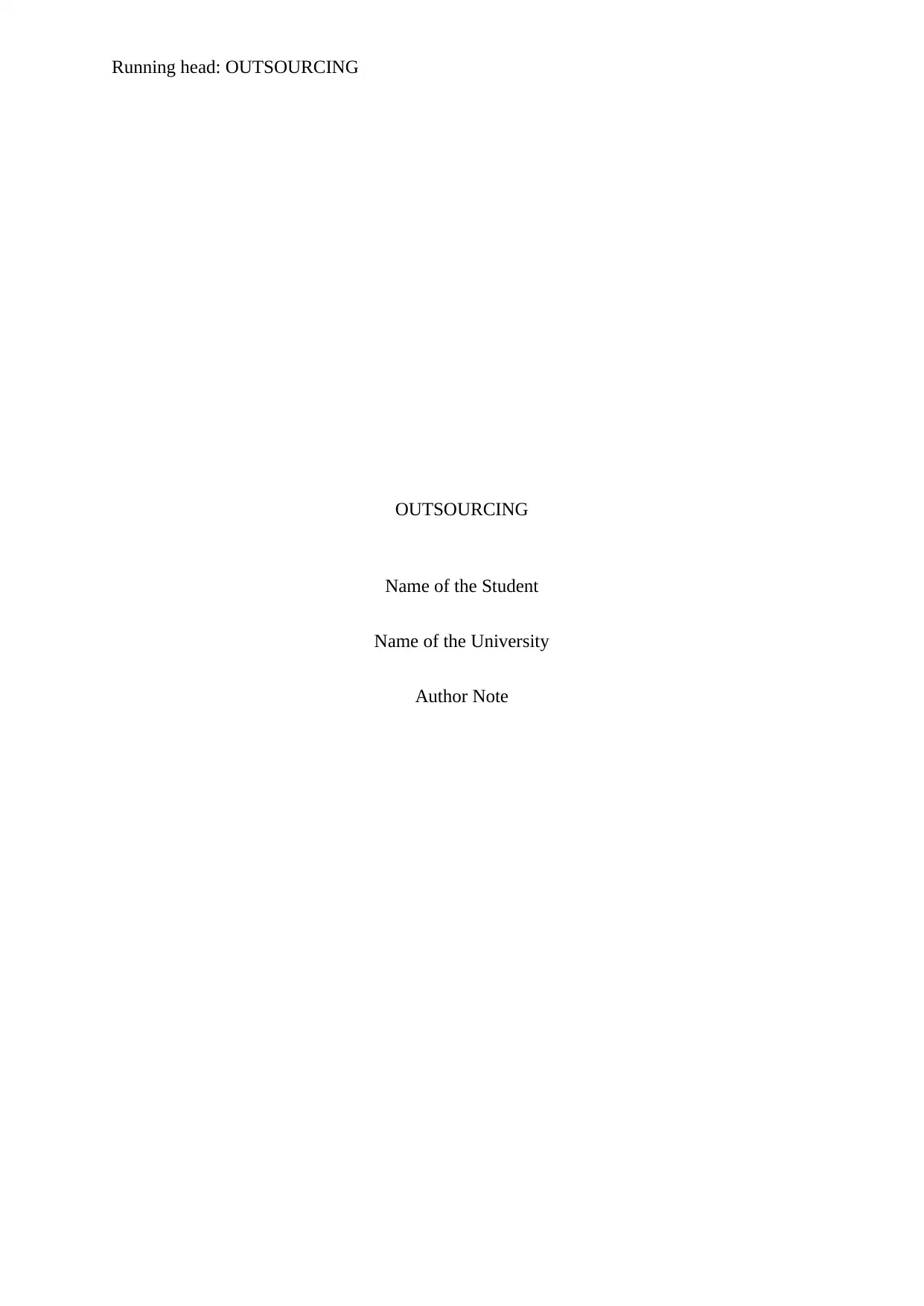
Running head: OUTSOURCING
OUTSOURCING
Name of the Student
Name of the University
Author Note
OUTSOURCING
Name of the Student
Name of the University
Author Note
Paraphrase This Document
Need a fresh take? Get an instant paraphrase of this document with our AI Paraphraser
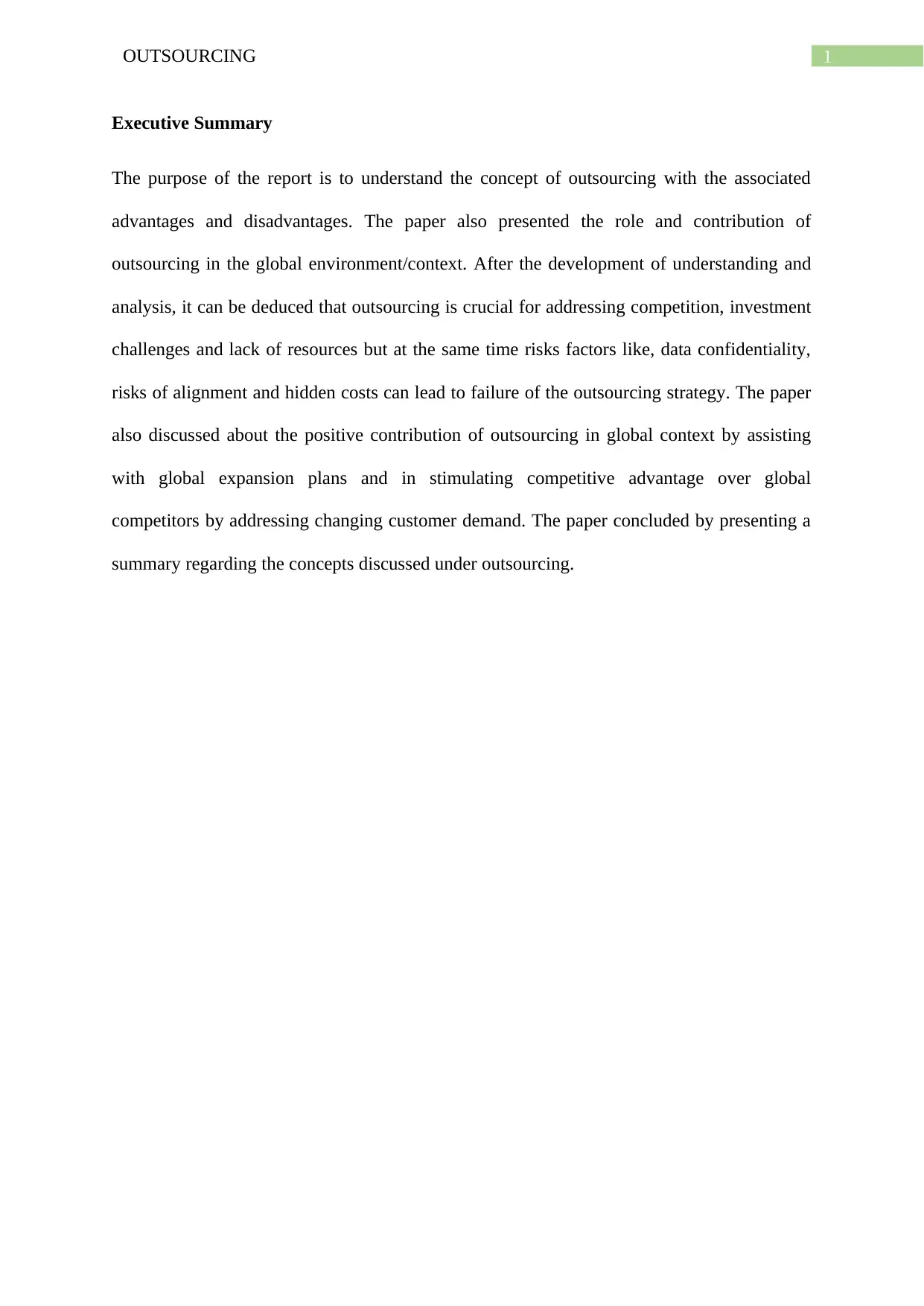
1OUTSOURCING
Executive Summary
The purpose of the report is to understand the concept of outsourcing with the associated
advantages and disadvantages. The paper also presented the role and contribution of
outsourcing in the global environment/context. After the development of understanding and
analysis, it can be deduced that outsourcing is crucial for addressing competition, investment
challenges and lack of resources but at the same time risks factors like, data confidentiality,
risks of alignment and hidden costs can lead to failure of the outsourcing strategy. The paper
also discussed about the positive contribution of outsourcing in global context by assisting
with global expansion plans and in stimulating competitive advantage over global
competitors by addressing changing customer demand. The paper concluded by presenting a
summary regarding the concepts discussed under outsourcing.
Executive Summary
The purpose of the report is to understand the concept of outsourcing with the associated
advantages and disadvantages. The paper also presented the role and contribution of
outsourcing in the global environment/context. After the development of understanding and
analysis, it can be deduced that outsourcing is crucial for addressing competition, investment
challenges and lack of resources but at the same time risks factors like, data confidentiality,
risks of alignment and hidden costs can lead to failure of the outsourcing strategy. The paper
also discussed about the positive contribution of outsourcing in global context by assisting
with global expansion plans and in stimulating competitive advantage over global
competitors by addressing changing customer demand. The paper concluded by presenting a
summary regarding the concepts discussed under outsourcing.
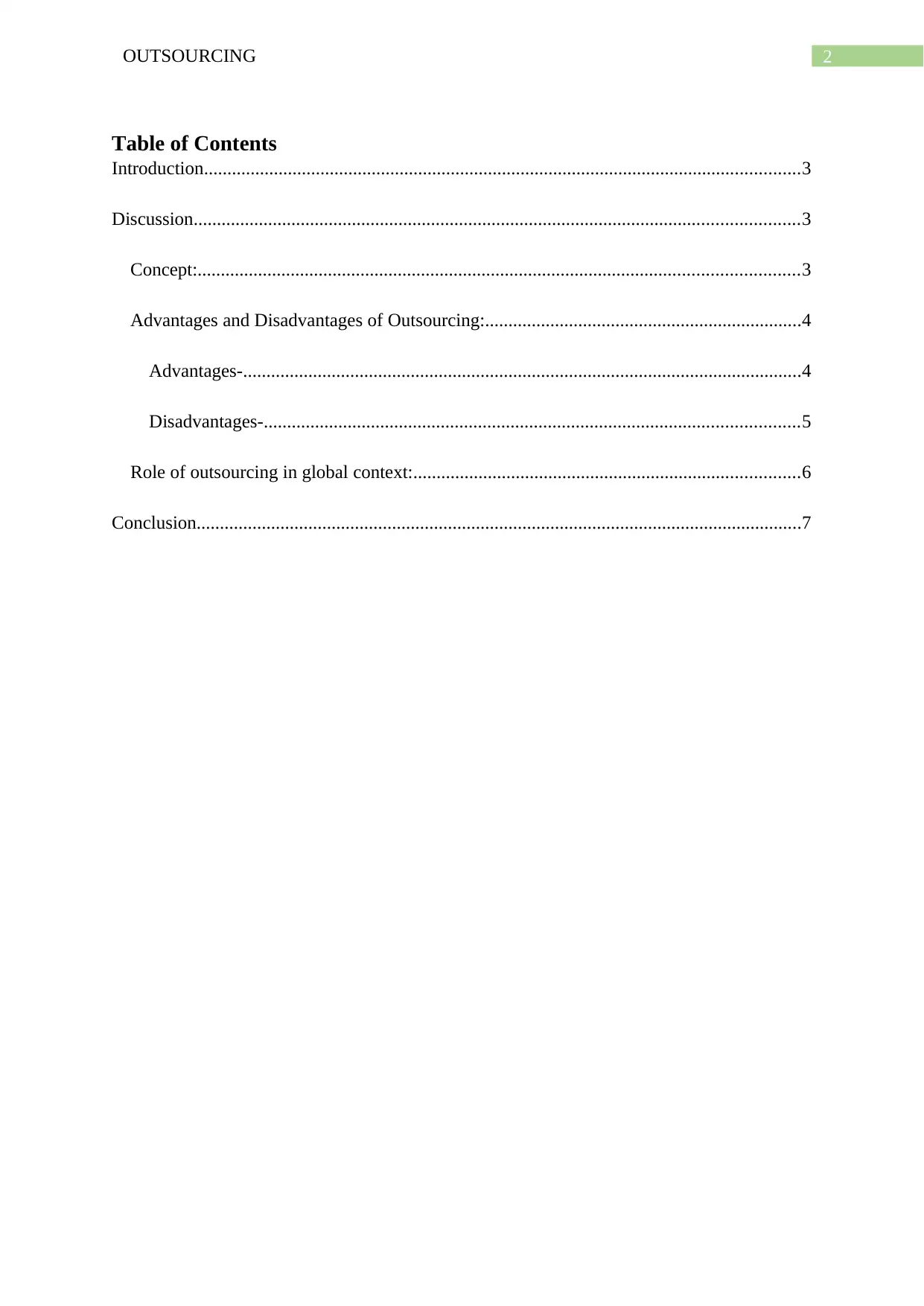
2OUTSOURCING
Table of Contents
Introduction................................................................................................................................3
Discussion..................................................................................................................................3
Concept:.................................................................................................................................3
Advantages and Disadvantages of Outsourcing:....................................................................4
Advantages-........................................................................................................................4
Disadvantages-...................................................................................................................5
Role of outsourcing in global context:...................................................................................6
Conclusion..................................................................................................................................7
Table of Contents
Introduction................................................................................................................................3
Discussion..................................................................................................................................3
Concept:.................................................................................................................................3
Advantages and Disadvantages of Outsourcing:....................................................................4
Advantages-........................................................................................................................4
Disadvantages-...................................................................................................................5
Role of outsourcing in global context:...................................................................................6
Conclusion..................................................................................................................................7
⊘ This is a preview!⊘
Do you want full access?
Subscribe today to unlock all pages.

Trusted by 1+ million students worldwide
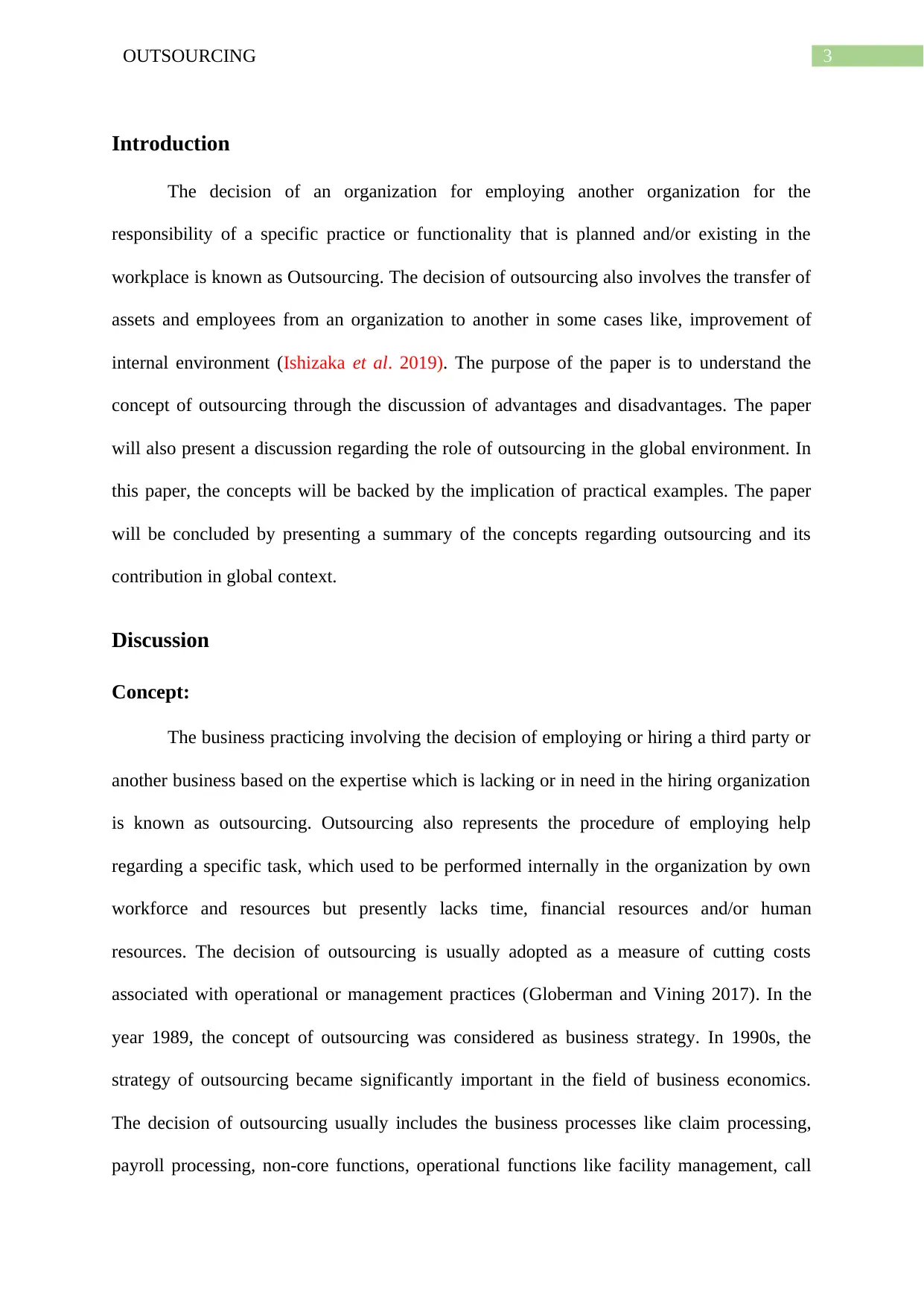
3OUTSOURCING
Introduction
The decision of an organization for employing another organization for the
responsibility of a specific practice or functionality that is planned and/or existing in the
workplace is known as Outsourcing. The decision of outsourcing also involves the transfer of
assets and employees from an organization to another in some cases like, improvement of
internal environment (Ishizaka et al. 2019). The purpose of the paper is to understand the
concept of outsourcing through the discussion of advantages and disadvantages. The paper
will also present a discussion regarding the role of outsourcing in the global environment. In
this paper, the concepts will be backed by the implication of practical examples. The paper
will be concluded by presenting a summary of the concepts regarding outsourcing and its
contribution in global context.
Discussion
Concept:
The business practicing involving the decision of employing or hiring a third party or
another business based on the expertise which is lacking or in need in the hiring organization
is known as outsourcing. Outsourcing also represents the procedure of employing help
regarding a specific task, which used to be performed internally in the organization by own
workforce and resources but presently lacks time, financial resources and/or human
resources. The decision of outsourcing is usually adopted as a measure of cutting costs
associated with operational or management practices (Globerman and Vining 2017). In the
year 1989, the concept of outsourcing was considered as business strategy. In 1990s, the
strategy of outsourcing became significantly important in the field of business economics.
The decision of outsourcing usually includes the business processes like claim processing,
payroll processing, non-core functions, operational functions like facility management, call
Introduction
The decision of an organization for employing another organization for the
responsibility of a specific practice or functionality that is planned and/or existing in the
workplace is known as Outsourcing. The decision of outsourcing also involves the transfer of
assets and employees from an organization to another in some cases like, improvement of
internal environment (Ishizaka et al. 2019). The purpose of the paper is to understand the
concept of outsourcing through the discussion of advantages and disadvantages. The paper
will also present a discussion regarding the role of outsourcing in the global environment. In
this paper, the concepts will be backed by the implication of practical examples. The paper
will be concluded by presenting a summary of the concepts regarding outsourcing and its
contribution in global context.
Discussion
Concept:
The business practicing involving the decision of employing or hiring a third party or
another business based on the expertise which is lacking or in need in the hiring organization
is known as outsourcing. Outsourcing also represents the procedure of employing help
regarding a specific task, which used to be performed internally in the organization by own
workforce and resources but presently lacks time, financial resources and/or human
resources. The decision of outsourcing is usually adopted as a measure of cutting costs
associated with operational or management practices (Globerman and Vining 2017). In the
year 1989, the concept of outsourcing was considered as business strategy. In 1990s, the
strategy of outsourcing became significantly important in the field of business economics.
The decision of outsourcing usually includes the business processes like claim processing,
payroll processing, non-core functions, operational functions like facility management, call
Paraphrase This Document
Need a fresh take? Get an instant paraphrase of this document with our AI Paraphraser
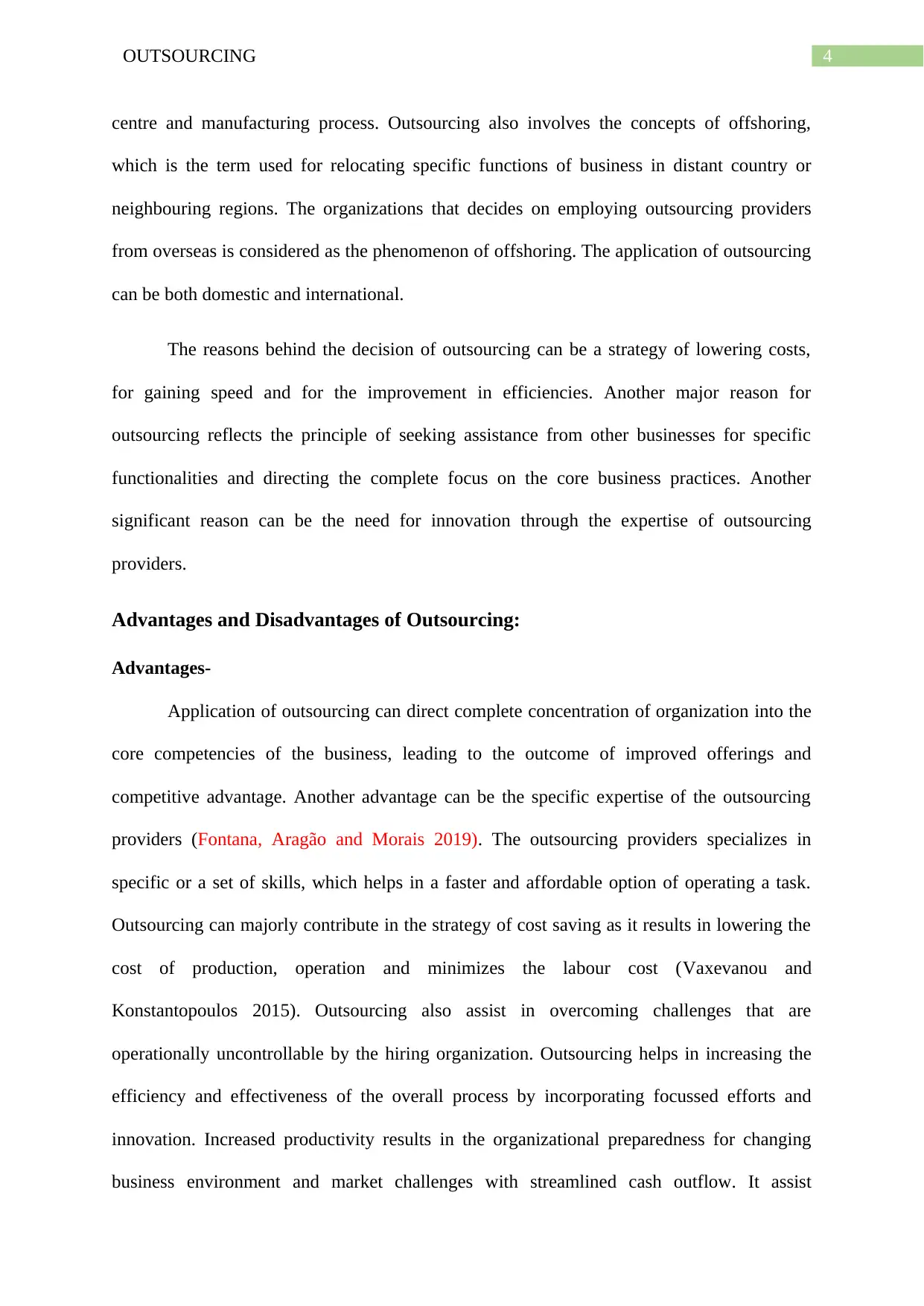
4OUTSOURCING
centre and manufacturing process. Outsourcing also involves the concepts of offshoring,
which is the term used for relocating specific functions of business in distant country or
neighbouring regions. The organizations that decides on employing outsourcing providers
from overseas is considered as the phenomenon of offshoring. The application of outsourcing
can be both domestic and international.
The reasons behind the decision of outsourcing can be a strategy of lowering costs,
for gaining speed and for the improvement in efficiencies. Another major reason for
outsourcing reflects the principle of seeking assistance from other businesses for specific
functionalities and directing the complete focus on the core business practices. Another
significant reason can be the need for innovation through the expertise of outsourcing
providers.
Advantages and Disadvantages of Outsourcing:
Advantages-
Application of outsourcing can direct complete concentration of organization into the
core competencies of the business, leading to the outcome of improved offerings and
competitive advantage. Another advantage can be the specific expertise of the outsourcing
providers (Fontana, Aragão and Morais 2019). The outsourcing providers specializes in
specific or a set of skills, which helps in a faster and affordable option of operating a task.
Outsourcing can majorly contribute in the strategy of cost saving as it results in lowering the
cost of production, operation and minimizes the labour cost (Vaxevanou and
Konstantopoulos 2015). Outsourcing also assist in overcoming challenges that are
operationally uncontrollable by the hiring organization. Outsourcing helps in increasing the
efficiency and effectiveness of the overall process by incorporating focussed efforts and
innovation. Increased productivity results in the organizational preparedness for changing
business environment and market challenges with streamlined cash outflow. It assist
centre and manufacturing process. Outsourcing also involves the concepts of offshoring,
which is the term used for relocating specific functions of business in distant country or
neighbouring regions. The organizations that decides on employing outsourcing providers
from overseas is considered as the phenomenon of offshoring. The application of outsourcing
can be both domestic and international.
The reasons behind the decision of outsourcing can be a strategy of lowering costs,
for gaining speed and for the improvement in efficiencies. Another major reason for
outsourcing reflects the principle of seeking assistance from other businesses for specific
functionalities and directing the complete focus on the core business practices. Another
significant reason can be the need for innovation through the expertise of outsourcing
providers.
Advantages and Disadvantages of Outsourcing:
Advantages-
Application of outsourcing can direct complete concentration of organization into the
core competencies of the business, leading to the outcome of improved offerings and
competitive advantage. Another advantage can be the specific expertise of the outsourcing
providers (Fontana, Aragão and Morais 2019). The outsourcing providers specializes in
specific or a set of skills, which helps in a faster and affordable option of operating a task.
Outsourcing can majorly contribute in the strategy of cost saving as it results in lowering the
cost of production, operation and minimizes the labour cost (Vaxevanou and
Konstantopoulos 2015). Outsourcing also assist in overcoming challenges that are
operationally uncontrollable by the hiring organization. Outsourcing helps in increasing the
efficiency and effectiveness of the overall process by incorporating focussed efforts and
innovation. Increased productivity results in the organizational preparedness for changing
business environment and market challenges with streamlined cash outflow. It assist
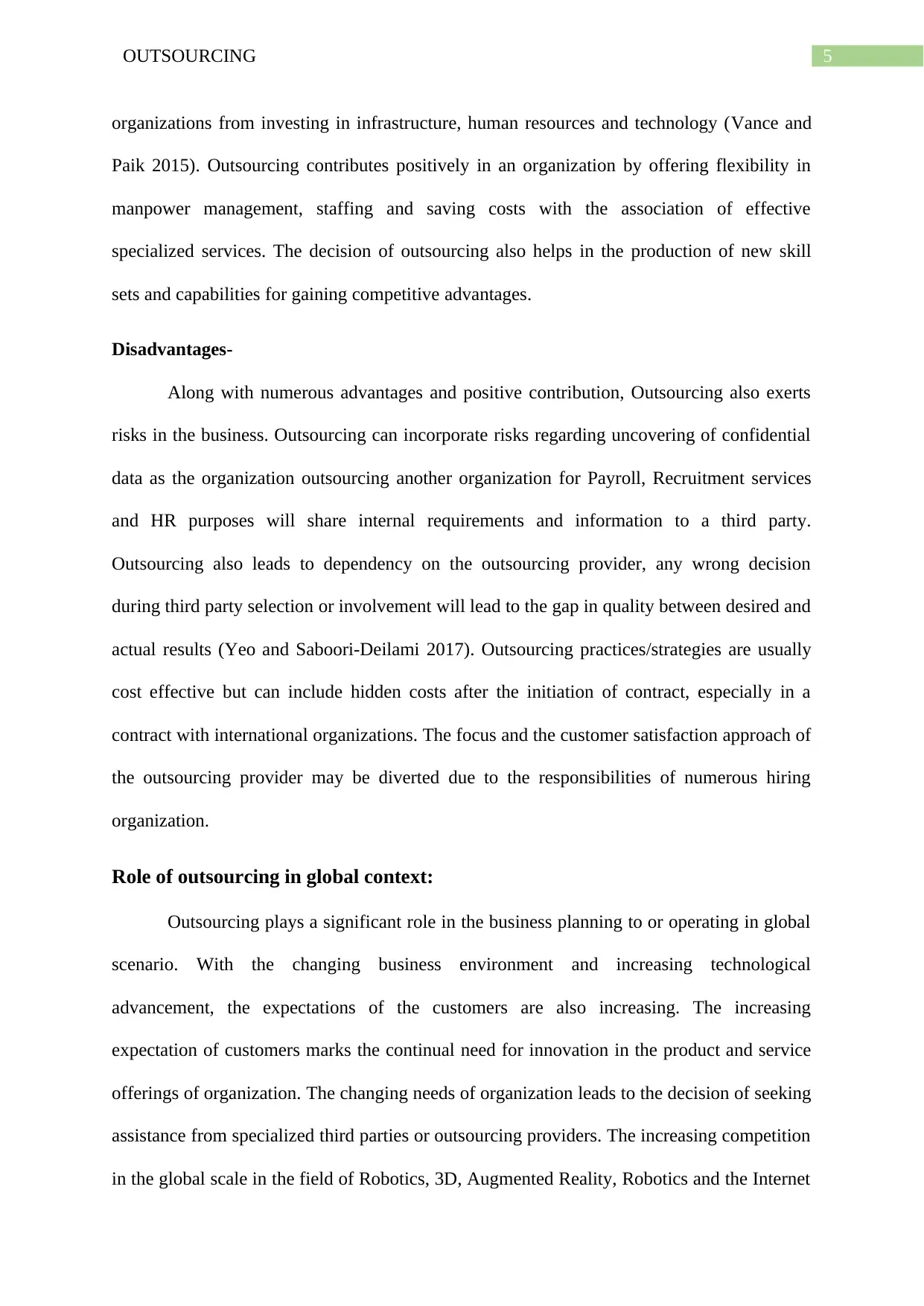
5OUTSOURCING
organizations from investing in infrastructure, human resources and technology (Vance and
Paik 2015). Outsourcing contributes positively in an organization by offering flexibility in
manpower management, staffing and saving costs with the association of effective
specialized services. The decision of outsourcing also helps in the production of new skill
sets and capabilities for gaining competitive advantages.
Disadvantages-
Along with numerous advantages and positive contribution, Outsourcing also exerts
risks in the business. Outsourcing can incorporate risks regarding uncovering of confidential
data as the organization outsourcing another organization for Payroll, Recruitment services
and HR purposes will share internal requirements and information to a third party.
Outsourcing also leads to dependency on the outsourcing provider, any wrong decision
during third party selection or involvement will lead to the gap in quality between desired and
actual results (Yeo and Saboori-Deilami 2017). Outsourcing practices/strategies are usually
cost effective but can include hidden costs after the initiation of contract, especially in a
contract with international organizations. The focus and the customer satisfaction approach of
the outsourcing provider may be diverted due to the responsibilities of numerous hiring
organization.
Role of outsourcing in global context:
Outsourcing plays a significant role in the business planning to or operating in global
scenario. With the changing business environment and increasing technological
advancement, the expectations of the customers are also increasing. The increasing
expectation of customers marks the continual need for innovation in the product and service
offerings of organization. The changing needs of organization leads to the decision of seeking
assistance from specialized third parties or outsourcing providers. The increasing competition
in the global scale in the field of Robotics, 3D, Augmented Reality, Robotics and the Internet
organizations from investing in infrastructure, human resources and technology (Vance and
Paik 2015). Outsourcing contributes positively in an organization by offering flexibility in
manpower management, staffing and saving costs with the association of effective
specialized services. The decision of outsourcing also helps in the production of new skill
sets and capabilities for gaining competitive advantages.
Disadvantages-
Along with numerous advantages and positive contribution, Outsourcing also exerts
risks in the business. Outsourcing can incorporate risks regarding uncovering of confidential
data as the organization outsourcing another organization for Payroll, Recruitment services
and HR purposes will share internal requirements and information to a third party.
Outsourcing also leads to dependency on the outsourcing provider, any wrong decision
during third party selection or involvement will lead to the gap in quality between desired and
actual results (Yeo and Saboori-Deilami 2017). Outsourcing practices/strategies are usually
cost effective but can include hidden costs after the initiation of contract, especially in a
contract with international organizations. The focus and the customer satisfaction approach of
the outsourcing provider may be diverted due to the responsibilities of numerous hiring
organization.
Role of outsourcing in global context:
Outsourcing plays a significant role in the business planning to or operating in global
scenario. With the changing business environment and increasing technological
advancement, the expectations of the customers are also increasing. The increasing
expectation of customers marks the continual need for innovation in the product and service
offerings of organization. The changing needs of organization leads to the decision of seeking
assistance from specialized third parties or outsourcing providers. The increasing competition
in the global scale in the field of Robotics, 3D, Augmented Reality, Robotics and the Internet
⊘ This is a preview!⊘
Do you want full access?
Subscribe today to unlock all pages.

Trusted by 1+ million students worldwide
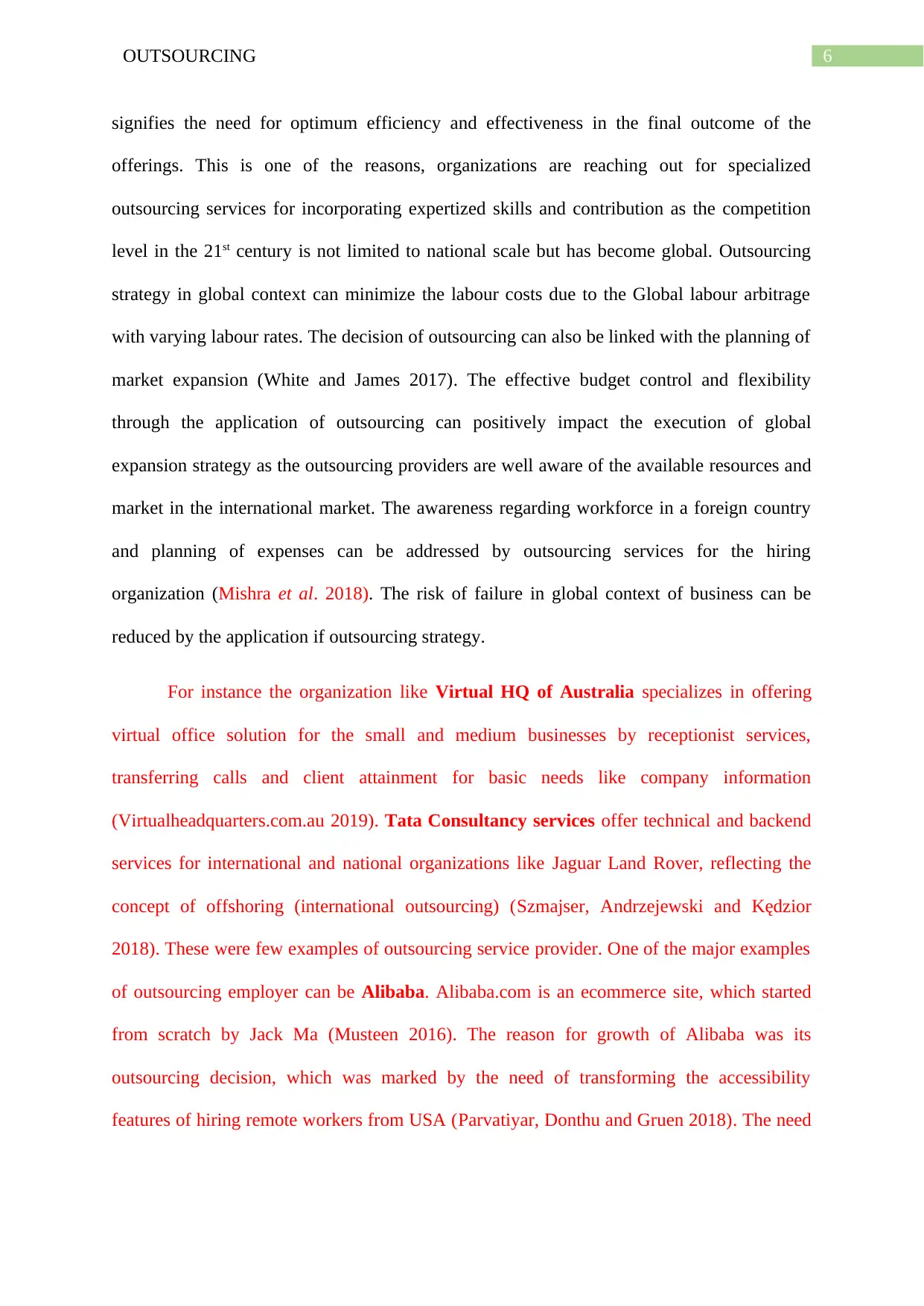
6OUTSOURCING
signifies the need for optimum efficiency and effectiveness in the final outcome of the
offerings. This is one of the reasons, organizations are reaching out for specialized
outsourcing services for incorporating expertized skills and contribution as the competition
level in the 21st century is not limited to national scale but has become global. Outsourcing
strategy in global context can minimize the labour costs due to the Global labour arbitrage
with varying labour rates. The decision of outsourcing can also be linked with the planning of
market expansion (White and James 2017). The effective budget control and flexibility
through the application of outsourcing can positively impact the execution of global
expansion strategy as the outsourcing providers are well aware of the available resources and
market in the international market. The awareness regarding workforce in a foreign country
and planning of expenses can be addressed by outsourcing services for the hiring
organization (Mishra et al. 2018). The risk of failure in global context of business can be
reduced by the application if outsourcing strategy.
For instance the organization like Virtual HQ of Australia specializes in offering
virtual office solution for the small and medium businesses by receptionist services,
transferring calls and client attainment for basic needs like company information
(Virtualheadquarters.com.au 2019). Tata Consultancy services offer technical and backend
services for international and national organizations like Jaguar Land Rover, reflecting the
concept of offshoring (international outsourcing) (Szmajser, Andrzejewski and Kędzior
2018). These were few examples of outsourcing service provider. One of the major examples
of outsourcing employer can be Alibaba. Alibaba.com is an ecommerce site, which started
from scratch by Jack Ma (Musteen 2016). The reason for growth of Alibaba was its
outsourcing decision, which was marked by the need of transforming the accessibility
features of hiring remote workers from USA (Parvatiyar, Donthu and Gruen 2018). The need
signifies the need for optimum efficiency and effectiveness in the final outcome of the
offerings. This is one of the reasons, organizations are reaching out for specialized
outsourcing services for incorporating expertized skills and contribution as the competition
level in the 21st century is not limited to national scale but has become global. Outsourcing
strategy in global context can minimize the labour costs due to the Global labour arbitrage
with varying labour rates. The decision of outsourcing can also be linked with the planning of
market expansion (White and James 2017). The effective budget control and flexibility
through the application of outsourcing can positively impact the execution of global
expansion strategy as the outsourcing providers are well aware of the available resources and
market in the international market. The awareness regarding workforce in a foreign country
and planning of expenses can be addressed by outsourcing services for the hiring
organization (Mishra et al. 2018). The risk of failure in global context of business can be
reduced by the application if outsourcing strategy.
For instance the organization like Virtual HQ of Australia specializes in offering
virtual office solution for the small and medium businesses by receptionist services,
transferring calls and client attainment for basic needs like company information
(Virtualheadquarters.com.au 2019). Tata Consultancy services offer technical and backend
services for international and national organizations like Jaguar Land Rover, reflecting the
concept of offshoring (international outsourcing) (Szmajser, Andrzejewski and Kędzior
2018). These were few examples of outsourcing service provider. One of the major examples
of outsourcing employer can be Alibaba. Alibaba.com is an ecommerce site, which started
from scratch by Jack Ma (Musteen 2016). The reason for growth of Alibaba was its
outsourcing decision, which was marked by the need of transforming the accessibility
features of hiring remote workers from USA (Parvatiyar, Donthu and Gruen 2018). The need
Paraphrase This Document
Need a fresh take? Get an instant paraphrase of this document with our AI Paraphraser
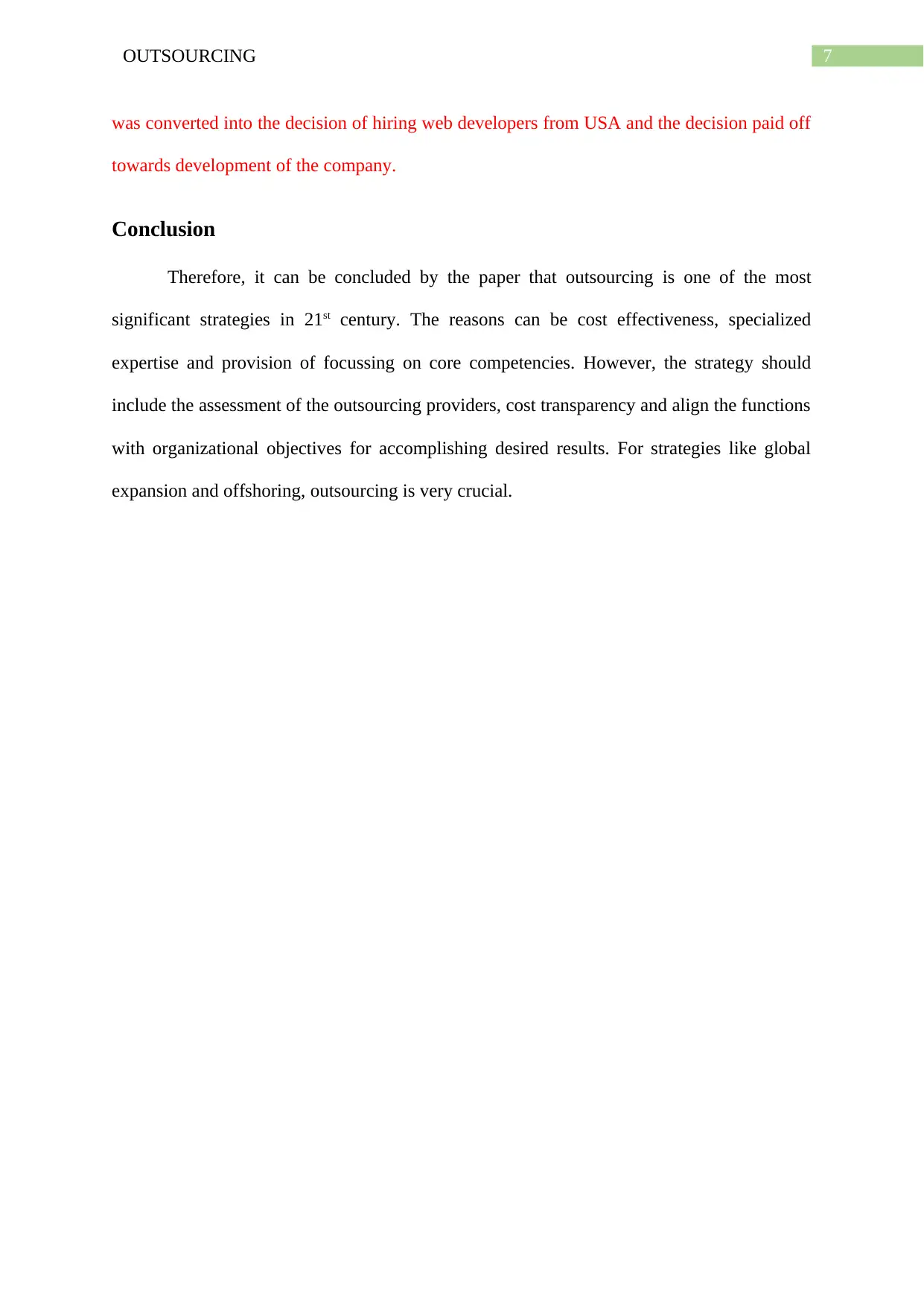
7OUTSOURCING
was converted into the decision of hiring web developers from USA and the decision paid off
towards development of the company.
Conclusion
Therefore, it can be concluded by the paper that outsourcing is one of the most
significant strategies in 21st century. The reasons can be cost effectiveness, specialized
expertise and provision of focussing on core competencies. However, the strategy should
include the assessment of the outsourcing providers, cost transparency and align the functions
with organizational objectives for accomplishing desired results. For strategies like global
expansion and offshoring, outsourcing is very crucial.
was converted into the decision of hiring web developers from USA and the decision paid off
towards development of the company.
Conclusion
Therefore, it can be concluded by the paper that outsourcing is one of the most
significant strategies in 21st century. The reasons can be cost effectiveness, specialized
expertise and provision of focussing on core competencies. However, the strategy should
include the assessment of the outsourcing providers, cost transparency and align the functions
with organizational objectives for accomplishing desired results. For strategies like global
expansion and offshoring, outsourcing is very crucial.
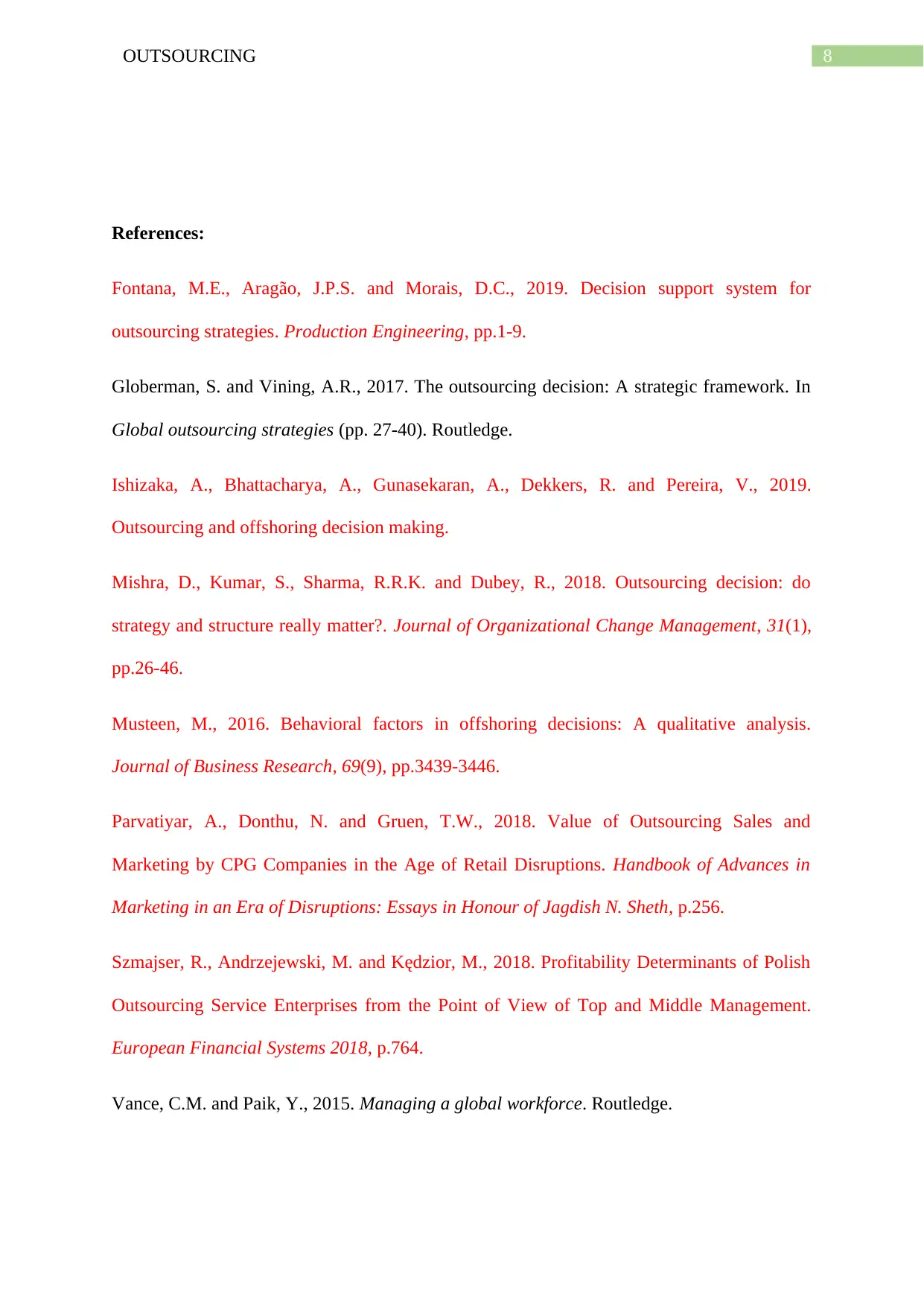
8OUTSOURCING
References:
Fontana, M.E., Aragão, J.P.S. and Morais, D.C., 2019. Decision support system for
outsourcing strategies. Production Engineering, pp.1-9.
Globerman, S. and Vining, A.R., 2017. The outsourcing decision: A strategic framework. In
Global outsourcing strategies (pp. 27-40). Routledge.
Ishizaka, A., Bhattacharya, A., Gunasekaran, A., Dekkers, R. and Pereira, V., 2019.
Outsourcing and offshoring decision making.
Mishra, D., Kumar, S., Sharma, R.R.K. and Dubey, R., 2018. Outsourcing decision: do
strategy and structure really matter?. Journal of Organizational Change Management, 31(1),
pp.26-46.
Musteen, M., 2016. Behavioral factors in offshoring decisions: A qualitative analysis.
Journal of Business Research, 69(9), pp.3439-3446.
Parvatiyar, A., Donthu, N. and Gruen, T.W., 2018. Value of Outsourcing Sales and
Marketing by CPG Companies in the Age of Retail Disruptions. Handbook of Advances in
Marketing in an Era of Disruptions: Essays in Honour of Jagdish N. Sheth, p.256.
Szmajser, R., Andrzejewski, M. and Kędzior, M., 2018. Profitability Determinants of Polish
Outsourcing Service Enterprises from the Point of View of Top and Middle Management.
European Financial Systems 2018, p.764.
Vance, C.M. and Paik, Y., 2015. Managing a global workforce. Routledge.
References:
Fontana, M.E., Aragão, J.P.S. and Morais, D.C., 2019. Decision support system for
outsourcing strategies. Production Engineering, pp.1-9.
Globerman, S. and Vining, A.R., 2017. The outsourcing decision: A strategic framework. In
Global outsourcing strategies (pp. 27-40). Routledge.
Ishizaka, A., Bhattacharya, A., Gunasekaran, A., Dekkers, R. and Pereira, V., 2019.
Outsourcing and offshoring decision making.
Mishra, D., Kumar, S., Sharma, R.R.K. and Dubey, R., 2018. Outsourcing decision: do
strategy and structure really matter?. Journal of Organizational Change Management, 31(1),
pp.26-46.
Musteen, M., 2016. Behavioral factors in offshoring decisions: A qualitative analysis.
Journal of Business Research, 69(9), pp.3439-3446.
Parvatiyar, A., Donthu, N. and Gruen, T.W., 2018. Value of Outsourcing Sales and
Marketing by CPG Companies in the Age of Retail Disruptions. Handbook of Advances in
Marketing in an Era of Disruptions: Essays in Honour of Jagdish N. Sheth, p.256.
Szmajser, R., Andrzejewski, M. and Kędzior, M., 2018. Profitability Determinants of Polish
Outsourcing Service Enterprises from the Point of View of Top and Middle Management.
European Financial Systems 2018, p.764.
Vance, C.M. and Paik, Y., 2015. Managing a global workforce. Routledge.
⊘ This is a preview!⊘
Do you want full access?
Subscribe today to unlock all pages.

Trusted by 1+ million students worldwide
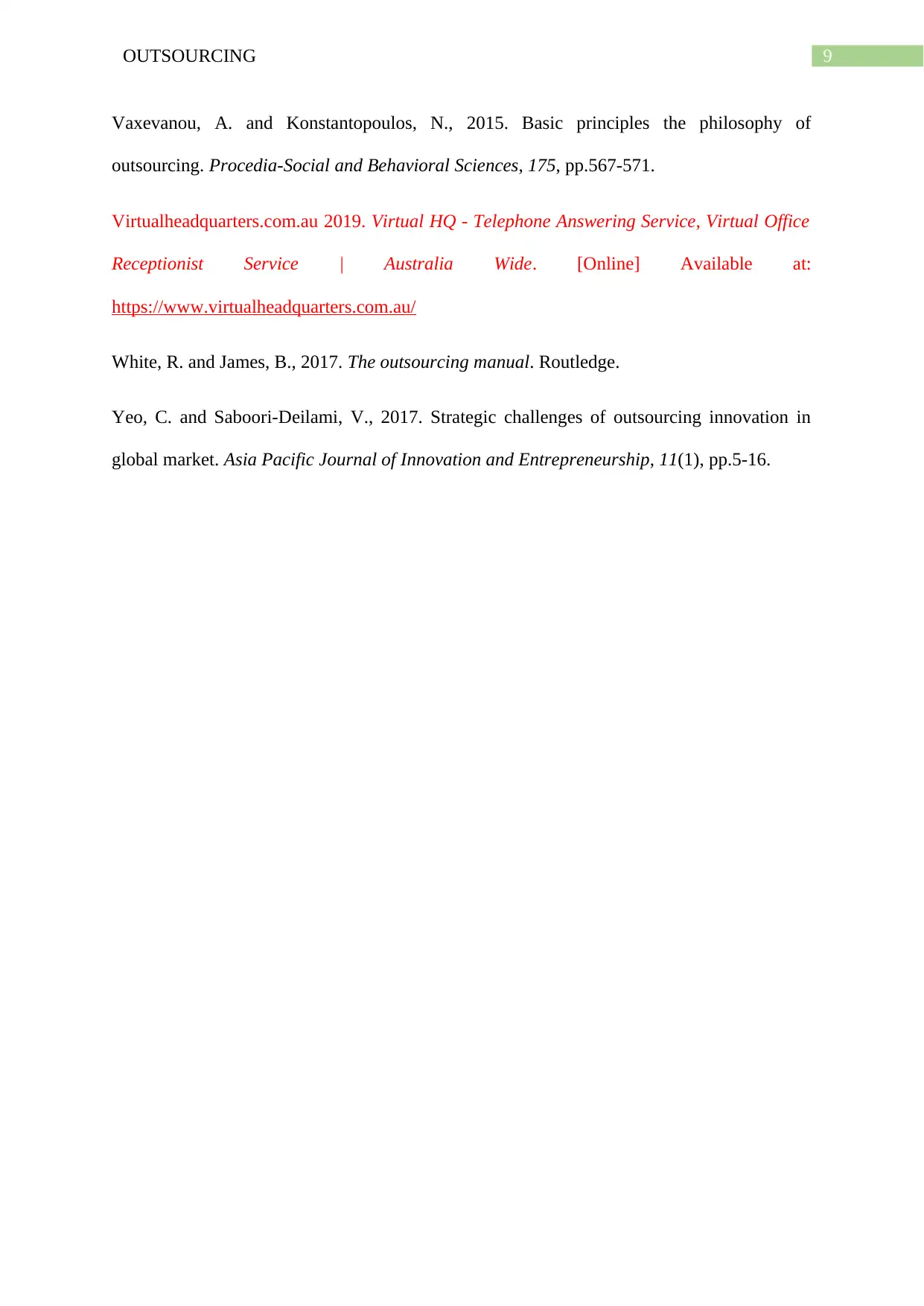
9OUTSOURCING
Vaxevanou, A. and Konstantopoulos, N., 2015. Basic principles the philosophy of
outsourcing. Procedia-Social and Behavioral Sciences, 175, pp.567-571.
Virtualheadquarters.com.au 2019. Virtual HQ - Telephone Answering Service, Virtual Office
Receptionist Service | Australia Wide. [Online] Available at:
https://www.virtualheadquarters.com.au/
White, R. and James, B., 2017. The outsourcing manual. Routledge.
Yeo, C. and Saboori-Deilami, V., 2017. Strategic challenges of outsourcing innovation in
global market. Asia Pacific Journal of Innovation and Entrepreneurship, 11(1), pp.5-16.
Vaxevanou, A. and Konstantopoulos, N., 2015. Basic principles the philosophy of
outsourcing. Procedia-Social and Behavioral Sciences, 175, pp.567-571.
Virtualheadquarters.com.au 2019. Virtual HQ - Telephone Answering Service, Virtual Office
Receptionist Service | Australia Wide. [Online] Available at:
https://www.virtualheadquarters.com.au/
White, R. and James, B., 2017. The outsourcing manual. Routledge.
Yeo, C. and Saboori-Deilami, V., 2017. Strategic challenges of outsourcing innovation in
global market. Asia Pacific Journal of Innovation and Entrepreneurship, 11(1), pp.5-16.
1 out of 10
Related Documents
Your All-in-One AI-Powered Toolkit for Academic Success.
+13062052269
info@desklib.com
Available 24*7 on WhatsApp / Email
![[object Object]](/_next/static/media/star-bottom.7253800d.svg)
Unlock your academic potential
Copyright © 2020–2025 A2Z Services. All Rights Reserved. Developed and managed by ZUCOL.





